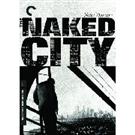|
|
||||
|
|
by Donald Levit  Imitation sincerely flatters but also blunts the impact of its models. Exhibit A is The Naked City, subsequent police procedurals and TV series having diluted its original effect over the sixty-three years since its neo-documentary depiction of crime and punishment. William Daniels’ crisp black-and-white camerawork won him an Oscar for this 1948 film since selected for the Library of Congress’ National Film Registry and, indeed, is justification for its inclusion in documentary-oriented Maysles Cinema’s quarterly “True Crime Producer Mark Hellinger, director Jules Dassin, and Universal International had also teamed up the year before on prison melodrama Brute Force. Casual mention before HUAC would drive Dassin into exile after 1949 Thieves’ Highway, while co-screenwriter Albert Maltz was among the Hollywood Ten, imprisoned, and blacklisted for twenty-two years. Nevertheless, NC does not beat any drum for social consciousness, subsequent such readings-in arising in European leftist intellectuals’ lionizing of the director. An additional non-fiction-like touch, the film’s pervasive narration from start to finish is today unintentionally humorous. Hellinger died before commercial release, but the pretentious corniness of his former tabloid journalism is evident in his supposedly no-nonsense masculine voiceover, even if his postscript about one story among eight million forever entered the American vocabulary through the homonymous trendsetting ‘50s-‘60s television cop show. Despite established stars and later-famous character players, the lone touch of real flesh, of sweat, nastiness, even sensuality, is Ted de Corsia’s harmonica-playing ex-wrestler Willie Garza, whose face is not seen or identified until nearly the end. In the scheme of the story, it makes little difference who he really is as one of two men the peeping camera-eye catches at random through a window, anesthetizing and strangling a blonde, and soon drowning his tipsy accomplice in the The dead woman is Jean Dexter, a big city model, playgirl and schemer from a small town. In anticipation of later media feeding frenzy, the lurid but far from extraordinary crime is screamed across the front pages. Starting with zero clues, false leads, liars, self-servers and crank informers, detective work consists of sitting around discussing, walking the sidewalks to question every jeweler and pawnbroker, and communicating on office and public pay rotary telephones. Why so much homicide division time is devoted to this one case, for which theft seems the motive, is not the point, as the dull methodical routine of Among those brought in are rich fellow model Ruth Morrison (Dorothy Hart), her grifter fiancé Frank Niles (Howard Duff), society doctor Stoneman (House Jameson), and housemaids, janitors, parents and shop proprietors. The solution is involved but not very interesting and pales alongside the climactic pursuit. Not helped by bad DVD sound quality at the showing, The Naked City is not so good as its fame. The on-location photography and final minutes on the streets and bridge are impressive, but this noir is more memorable for what it inspired to follow it than in its slow talky self. (Released by Universal Pictures; not rated by MPAA.) |
||
|
© 2025 - ReelTalk Movie Reviews Website designed by Dot Pitch Studios, LLC |



